When I say you are dreaming, so am I
Come, walk with me. Observe, don’t just see. Look, always look again.
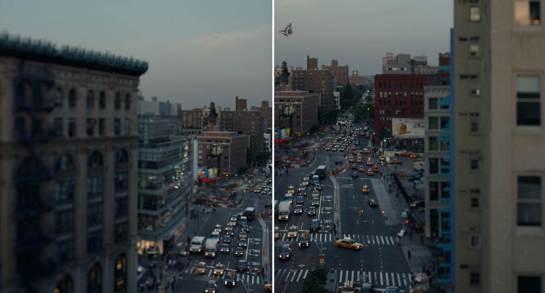
Using two cameras triggered in-synchronicity to capture one moment as a stereoscopic image, “Twilight Dreams of a Papilio Demoleus” delves into themes of personal identity, existence, and the twilight terrain they dwell in.
“Twilight Dreams of a Papilio Demoleus” beckons you like a child with a faint smile. Enchanted, you wander in her trail. Deserted train stations, open squares, back alleys, ribbons of asphalt clogged with traffic snaking through the city– places you thought you have seen enough, but in a blink of an eye, they seemed new again. But when did they transform? How? Why? Beautifully surreal, the work teases you with these questions as it unfolds in various nooks and crannies in New York City, where Singaporean artist John Clang is based in. Beyond its rich layers, lies what is possibly an intimate portrait of Clang’s innermost thoughts and emotions.
Central to Clang’s artistic approach is often the process of self-reflection and introspection. In Twilight Dreams, he draws inspiration from Taoist philosopher Zhuangzi, who wrote about his dream at end of the chapter of Qiwu lun 齐物论 (The Equality of Things). Zhuangzi dreamed himself to be a butterfly, which flied about happily. In it, he was perfectly clear about his identity, but after he awoken, this became uncertain. He then wondered whether he dreamed himself to be a butterfly, or the butterfly dreamed that he was Zhuangzi. According to researchers, Zhuangzi is exploring the Taoist idea of “naturalization” between man and nature. He is proposing that Man and nature are one of a whole, and that physical differences can be broken down as they are both constituted of Dao (The Way) and the original qi (life force). However, the analogy takes on a fresh interpretation in Clang, who saw it as an expression of the infinite possibilities and perspectives in life.
If awakening gives rise to ignorance or uncertainty, does it also mean in reality, we are all dreaming?
Too often have we been told, entertaining the ‘what ifs’ in life are impediments to moving ahead. To succeed in modern life is to be a realist with unwavering determination and decisiveness. Clang’s pictures are a refusal to subscribe to that. He feels there is no singular truth in this universe, and suggests that dreams and the subconscious run parallel to reality.
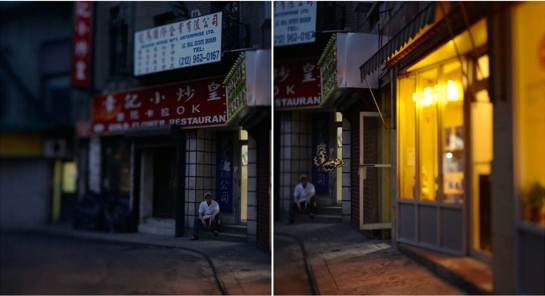
“To me, twilight is the pause in the rhythm of life as the day gradually winds down, thus opening up a private space to contemplate life and also to fret over the uncertainties of tomorrow.” – Clang
By positioning two cameras slightly apart from each other, he captures a moment he chances upon on the streets by triggering both cameras in-synchronicity to create a stereoscopic image. As our vision shifts between both frames, we observe differences in their focus or perspectives. Yet when placed side by side, they conjure a seamless picture, as though our eyes have blinked and refocused on the same scene.
Uniting each pair of pictures is the ethereal presence of the Lime Butterfly (Papilio Demoleus) commonly found in Singapore, which Clang has chosen to symbolise himself. The butterfly, besides also bearing reference to Zhuangzi’s dream, is also associated with time travel and chaos theory, where a small adjustment to a system can result in dramatically different outcomes.
Twilight Dreams also hints at references of Cubism, an art movement which arose in early 1900s to define a new modernity when science and technology were compelling Man to experience time, motion and space more dynamically. Then, philosophical theoreticians who interpreted the theory of relativity, proposed that we live in a world of shifting perspectives, where the appearance of objects is in a constant flux depending on the point of view. Moreover, exchanges between various cultures, which bring with them their unique way of viewing things, have greatly complicated the experience of reality and perception of truth. Relativity became the new reality.
With Clang exploring this notion with photography in the 21st century, have we perhaps come full circle?
The exploration of perspectives and reality is also an endeavour that is significant to the medium of photography. Because of the mechanics of a camera, perspective is something photography must always confront head on, unlike in painting, where abstraction can sometimes override traditional perspective. The photographic image is also simultaneously real and unreal. Despite being a reproduction, in Andre Bazin’s words, “it shares, by virtue of the very process of its becoming, the being of the model of which it is the reproduction; it is the model.”
Another interesting point lies in the fact that though Clang may not have consciously chosen Zhuangzi’s philosophy in reference to his cultural identity, the beliefs behind it are essentially eastern. Classical Chinese aesthetic envisions the body to be a harmonious composition of form, spirit, expression, and mental condition, without any distinction between flesh and subconscious. It stands in opposition to Western beliefs, from the philosopher Pythagoras onward, that body is purely a physical entity separate from the soul, and both elements are in conflict with each other.
The contemplation over alternatives may also be born out of a search for identity in a foreign land. The Singaporean identity is said to be vacuous, with citizens subscribing to a narrow definition of success. All we had to do was keep quiet, work hard, and we would triumph in this game of a race-neutral meritocracy by becoming rich. But cracks are appearing in this belief, and Clang, a photographer who has experienced the exhilarating freedom and spontaneity of New York, is convinced that there is more than one route to fulfillment.
Yet these myriad of possibilities and alternate paths, denied of the opportunity to become reality, are fragile and ambiguous. It is hence no coincidence that most of Clang’s pictures are shot in twilight, a time of the day marking a slowing down in the frenetic rhythm of life, where the last rays of sunlight disappear to make way for darkness. It is also a time for him to privately contemplate about life and muse over the uncertainties of tomorrow – a moment grips him with vulnerability but yet empowers him with hope at the same time.
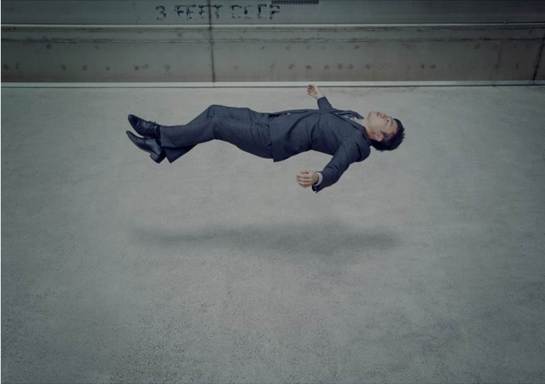
“The Myth of The Flat Earth” is a haunting icon and meditation of today’s nerve-wrecked urban humanity, and the desperate need to stay afloat — at all cost.
These mixed feelings carry forward in his newest work “The Myth of The Flat Earth”. His images are a visual representation of the urban human condition- the inescapable anxiety and pressure of falling in line. The title draws reference to a modern misconception that people in the Middle Ages believed that the world is flat instead of spherical, and that men who sail to the edges of earth will inevitably slip off its surface.
In the series, people appear to be threading on invisible water in an empty three feet pool, symbolic of their struggle to stay afloat and be relevant. Despite the irony that no water exists and there is absolutely no danger of drowning, the paranoia and competition of wanting to keep abreast of others is always present. Sharing a herd mentality, no one wants to be left behind and try standing.
The scenario draws reference to how we constantly conform to social expectations and yardsticks, represented by the water, which is invisible but having the potential to drown people, at least in their mind. In the video, we see an opposite scenario. There’s a realization that the pool is actually empty and there’s no need to thread water. But human nature, fraught with self-doubt, falls into the trap of self-sabotage by failing again to see the obvious. People immediately behave like a fish without water and start to suffocate, gasping for air.
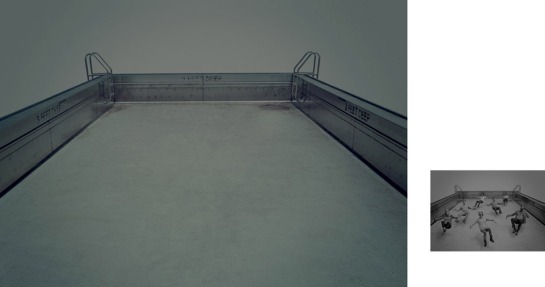
We are constantly struggling to stay afloat, head above water, even if we are actually treading on invisible waters in a pool barely deep enough to drown us.
This is a demonstration of the contradictions in human nature. On one hand, we worry that the metaphorical water will drown us, yet on the other, we cannot live without it for fear that its absence would render life meaningless. Clang acknowledges that the only certainty in the future that lies before us is uncertainty, but he is hopeful that there is courage in human spirit to thread bold steps through life, building an opportunity for ourselves to achieve a desired beautiful ending.
From the title, one literary relation that springs to mind is the book by New York Times’ columnist Thomas Friedman “The World is Flat” published in 2005. In it, Friedman examines how globalization, driven by technology, is demolishing cultural borders and physical distances, democratizing production and consumption, and essentially, flattening and eliminating differences and irregularities in the fabric of social life. Read in this light, can we infer that there is perhaps a kind of globalization of emotions in Clang’s work, where the fear of being left out, left behind, is amassing in not just developed nations, but developing ones as well? That digital technology has made it easier and faster for this cocktail of social anxiety to permeate various layers of social strata?
Clang’s pictures do not boast grand manifestos or overly elaborate techniques. Yet they never fail to surprise and captivate. The reason is blindingly simple: his visual expression lends a voice to the ones we’ve long silenced inside us. Curiosity, naivety, innocence, honesty to feelings – things abandoned in our drive to ‘make it’ in life – we find them again in Clang’s works.
For his ruminations make us rethink, if what we have lost was really worth losing.
About
John Clang was born Ang Choon Leng in Singapore, and earned his moniker in 1990 while serving in the army, where his badge read C L Ang. A visual artist currently based in New York, he is often inspired by the mundane and common place, creating works that are a rumination of his responses to daily encounters within a subtly changing environment.


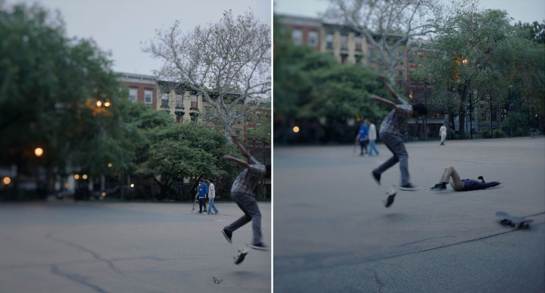
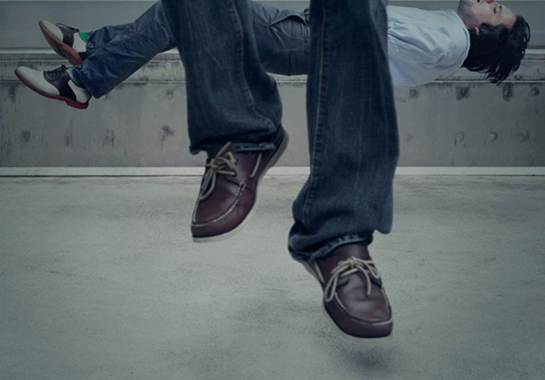
Pingback: Look and Look Again: Clang’s Diptychs and Butterflies | NSDMDH